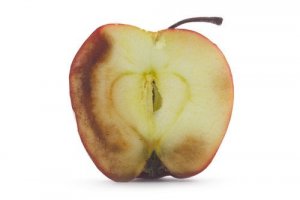The Consequences of Eating Oxidized Fruit


Written and verified by the nutritionist Saúl Sánchez Arias
Fruit oxidizes when it comes into contact with the air. This oxidation doesn’t mean the food is no longer suitable for consumption, but there are certain changes in it that you must take into account. Let’s find out what eating oxidized fruit entitles.
There are organoleptic changes and also changes in the nutritional composition that can affect the quality of the fruit and its function. Thus, you must try to avoid oxidized fruit.
The first consequence of oxidation is the appearance of free radicals. This may be related to a degeneration of human health, so you must limit their consumption. Even though there’s no clear evidence that the consumption of oxidized fruit is a risk factor for the development of certain diseases, it’s always better to avoid eating it in this state.
Note that oxidation is a chain reaction. There’s no stopping it once it starts until it fully rusts any susceptible substances. Apples and avocados are some of the most prone to oxidation.

Phenols in oxidized fruit
Contact with oxygen leads to a decrease in phenolic compounds. These are antioxidants that can reduce free radicals. Thus, the first consequence of oxidized fruit is that it decreases their natural health benefits.
The phenolic compounds come into contact with the enzyme polyphenol oxidase when you cut the fruit. At this time, the oxidation process that makes the pulp turn brown begins.
Keep in mind that free radicals lead to serious cellular effects and play an important role in degenerative diseases. So, you must consume antioxidants to prevent oxidative damage.
You may be interested: Six Research-Driven Health Benefits of Papayas
Vitamins in oxidized fruit
Similarly, there’s vitamin oxidation of the fruit as well. For instance, oxidation of vitamin C still permits the passage of this molecule but in an inactive form. As you can see, this process cancels out its effectiveness in any processes related to human health.
Thus, one can conclude that oxidation significantly reduces many of the fruit’s health benefits. Therefore, loss of vitamin functionality is significant and so is its antioxidant capacity.
How to avoid oxidized fruit?
Fruit containing citric acid doesn’t oxidize. So, apply lemon juice to pieces of fruit that are most susceptible to oxidation as it’ll reduce and delay the rusting process.
Likewise, there’s always the possibility of not allowing the fruit to come into contact with oxygen. Opt for storing them in plastic bags or vacuum packaging to efficiently prevent the oxidation process.
In the industry, they usually place food in modified atmospheres that contain less oxygen so as to delay rusting and increase its shelf life. In addition, cooling it also slows this process. Thus, storing the fruit in the refrigerator is a great way to prevent oxidation.

Read also: Ascorbic Acid – Uses and Benefits
Cooking is another option
Oxidation is a process you can prevent with heat. This is because it destroys the enzymes that cause it. So, cooking fruit together with other recipes can prevent oxidation and deterioration of their nutritional qualities.
For example, it’s very common for oxidation to occur in raw apples. However, they last a lot longer without damage to the pulp when you subject them to a thermal process in the oven.
Conclusion
Generally, eating oxidized fruit doesn’t pose a risk to human health. However, it does reduce the health properties of a given fruit.
Thus, you must exercise good conservation methods to delay this process. Finally, both cold citrus juice and vacuum packaging are good options to prevent oxidation.
All cited sources were thoroughly reviewed by our team to ensure their quality, reliability, currency, and validity. The bibliography of this article was considered reliable and of academic or scientific accuracy.
- Sharma GN., Gupta G., Sharma P., A comprehensive review of free radicals, antioxidants, and their relationship with human aliments. Crit Rev Eukaryot Gene Expr, 2018. 28 (2): 139-154.
- Hung PV., Phenolic compounds of cereals and their antioxidant capacity. Crit Rev Food Sci Nutr, 2016. 56 (1): 25-35.
- Dewhirst RA., Fry SC., The oxidation of dehydroascorbic acid and 2,3-diketogulonate by distinct reactive oxygen species. Biochem J, 2018. 475 (21): 3451-3470.
This text is provided for informational purposes only and does not replace consultation with a professional. If in doubt, consult your specialist.








